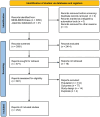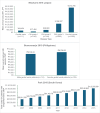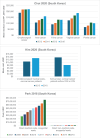Systematic literature review on the clinical and economic burden of human papillomavirus-related diseases in select areas in the Asia-Pacific region
- PMID: 39552456
- PMCID: PMC11581193
- DOI: 10.1080/21645515.2024.2425535
Systematic literature review on the clinical and economic burden of human papillomavirus-related diseases in select areas in the Asia-Pacific region
Abstract
Compared with Europe and America, adoption of human papillomavirus (HPV) vaccination into national immunization programs across the Asia-Pacific (AP) region has remained low. Moreover, HPV burden in this region has not been reviewed comprehensively. Therefore, this systematic literature review (SLR) aimed to summarize the clinical and economic burden of HPV and HPV-related diseases in select AP areas. An SLR was conducted January 2000-February 2022 using MEDLINE/Embase. Observational studies reporting incidence, prevalence, costs, or healthcare resource utilization (HCRU) of HPV and HPV-related disease among adults (≥18 years) from select AP areas were included. A total of 254 publications were included. Reported incidence per 100,000 person-years was 15.4-252.0 for cervical cancer (n = 5 publications), 0.2-55.5 for head and neck cancer (n = 7 publications), and 0.2-13.7 for anal cancer (n = 4 publications). Prevalence rates were 9.1%-100% for cervical cancer (n = 40 publications), 0.0%-95.6% for head and neck cancer (n = 48 publications), 0.0%-100% for anal cancer (n = 4 publications), 36.0%-79.6% for penile cancer (n = 4 publications), and 44.0%-82.0% for vaginal/vulvar cancer (n = 3 publications). Few studies reported on costs or HCRU, and high data variability was observed. Despite data variability, the high burden of HPV and HPV-related diseases makes clear the need for effective HPV screening, greater education, and reductions in vaccine hesitancy, particularly among lower- and middle-income areas. Improved data collection measures should be considered in data-scarce areas to better inform policy decision-making and improve monitoring of the impact of HPV vaccination.
Keywords: Asia Pacific; cost; genotype; healthcare resource utilization; human papillomavirus; incidence; prevalence.
Conflict of interest statement
Pei-Jen Lou: Received study funding from Merck Sharp & Dohme LLC, a subsidiary of Merck & Co., Inc., Rahway, NJ, USA. Wanatpreeya Phongsamart: Received study funding from Merck Sharp & Dohme LLC, a subsidiary of Merck & Co., Inc., Rahway, NJ, USA, and from GSK. Isaya Sukarom: Employee of MSD Thailand. Ying-Hui Wu: Employee of MSD Taiwan. Omer Zaidi, Frieda Du, Alyssa Simon, Mark Bernauer: Employees of OPEN Health. The authors declare no other competing interests.
Figures
Similar articles
-
A cost-effectiveness analysis of adult human papillomavirus vaccination strategies in Italy.Hum Vaccin Immunother. 2025 Dec;21(1):2474891. doi: 10.1080/21645515.2025.2474891. Epub 2025 Mar 17. Hum Vaccin Immunother. 2025. PMID: 40094352 Free PMC article.
-
Recommendations for cervical cancer prevention in Asia Pacific.Vaccine. 2008 Aug 19;26 Suppl 12:M89-98. doi: 10.1016/j.vaccine.2008.06.020. Vaccine. 2008. PMID: 18945418
-
The impact of Germany's human papillomavirus immunization program on HPV-related anogenital diseases: a retrospective analysis of claims data from statutory health insurances.Arch Gynecol Obstet. 2024 Nov;310(5):2639-2646. doi: 10.1007/s00404-024-07692-y. Epub 2024 Sep 4. Arch Gynecol Obstet. 2024. PMID: 39230793 Free PMC article.
-
Systematic review and evidence synthesis of non-cervical human papillomavirus-related disease health system costs and quality of life estimates.Sex Transm Infect. 2019 Feb;95(1):28-35. doi: 10.1136/sextrans-2018-053606. Epub 2018 Sep 21. Sex Transm Infect. 2019. PMID: 30674687
-
Epidemiology and burden of HPV-related disease.Best Pract Res Clin Obstet Gynaecol. 2018 Feb;47:14-26. doi: 10.1016/j.bpobgyn.2017.08.006. Epub 2017 Sep 2. Best Pract Res Clin Obstet Gynaecol. 2018. PMID: 29037457 Review.
Cited by
-
Cost-effectiveness of self-sampling and enhanced strategies for HPV prevention among men who have sex with men in China: a modeling study.BMC Med. 2025 Jul 1;23(1):362. doi: 10.1186/s12916-025-04131-w. BMC Med. 2025. PMID: 40597274 Free PMC article.
-
Enhancing Cervical Cancer Screening: New Diagnostic Methodologies, Triage, and Risk Stratification in Prevention and Treatment.Life (Basel). 2025 Feb 26;15(3):367. doi: 10.3390/life15030367. Life (Basel). 2025. PMID: 40141711 Free PMC article. Review.
References
-
- Brianti P, De Flammineis E, Mercuri SR.. Review of HPV-related diseases and cancers. New Microbiol. 2017. Apr;40(2):80–12. - PubMed
-
- de Sanjosé S, Diaz M, Castellsagué X, Clifford G, Bruni L, Muñoz N, Bosch FX. Worldwide prevalence and genotype distribution of cervical human papillomavirus DNA in women with normal cytology: a meta-analysis. Lancet Infect Dis. 2007. Jul;7(7):453–459. doi:10.1016/S1473-3099(07)70158-5. - DOI - PubMed
-
- Anic GM, Lee JH, Stockwell H, Rollison DE, Wu Y, Papenfuss MR, Villa LL, Lazcano-Ponce E, Gage C, Silva RJC, et al. Incidence and human papillomavirus (HPV) type distribution of genital warts in a multinational cohort of men: the HPV in Men Study. J Infect Dis. 2011. Dec 15. 204(12):1886–1892. doi:10.1093/infdis/jir652. - DOI - PMC - PubMed
Publication types
MeSH terms
Substances
LinkOut - more resources
Full Text Sources
Other Literature Sources
Medical




